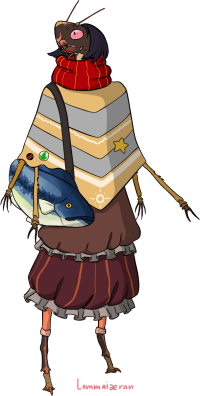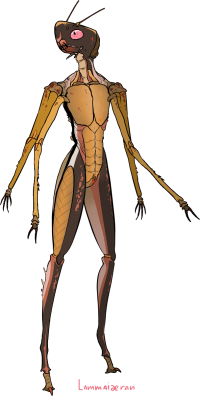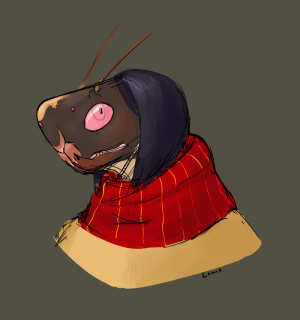Table of Contents
Atsila
 The Atsila are a species found on 220401, native to the world before its colonization efforts by a collection of refugees. Originally having lived on the western coast of the world, which now lays in ruin, the Atsila are a species that underwent a pseudo-apocalypse before, leading them to become an odd form of locust-like lifeforms. Currently, their population is about 1 to 2 billion in total, a testament to their slowly recovering species.
The Atsila are a species found on 220401, native to the world before its colonization efforts by a collection of refugees. Originally having lived on the western coast of the world, which now lays in ruin, the Atsila are a species that underwent a pseudo-apocalypse before, leading them to become an odd form of locust-like lifeforms. Currently, their population is about 1 to 2 billion in total, a testament to their slowly recovering species.
Physiology
While Atsila are humanoid in how they walk and partially are designed, they are far from it. Originally a species of bugs that lived on Bisahalani as prey, they adapted and grew as they outpaced their main predators. However, they originally were not nearly as tall, having undergone extreme evolutionary requirements over the last thousand or so YE after a nuclear war triggered by their original society and left part of their Pangaea-like world in utter ruin. However, with the reduction of land coupled with a slightly low gravity and an environment where their long stride and height were beneficial, it almost assured they changed from stocky, bulkier bugs into lean ones. They can come in many colors thanks to dormant and long-standing genetics alike.
With a stride that often has them standing around 2.4 to 2.7 meters and weighing an average of 45 to 57 kilograms, Atsila are commonly seen with four slender arms. The larger upper set of arms have four finger-like graspers, while the smaller lower arms have two feeler-oriented fingers. This unique set of hands allows them to use the upper arms to tear and pull things apart, while the lower are for more delicate moments and interactions that don't require strength. This unique adaption allows them the an equally adaptable manner of which to handle tasks, as the second set of arms can make them excellent at sewing clothes while spinning cloth, or feeding line into their fishing rods while the work. Their legs on the other hand, are far more simple thanks to having small claws that allow only basic stabilization.
Though their torso tends to be lean, it is packed with pectoral-like chitin to protect the Atsila and their bellies. This chitin is strongest on the front, however it covers the sides of their thighs, back, and arms. Though they no longer need it, it can endure basic amounts of standard trauma, such as getting kicked in the chest or hit with a club. It cannot, however, protect them from bullets thanks to needing to be light enough to allow them to walk. Their legs, in that same aspect, have enough plating to protect the muscles from any branches that might brush the sides of their legs as they run through brush.
Biological Developments
Biologically, their bodies maintain most of the crucial organs and the like seen in other humanoids… however, their skin is more akin to a thinner exoskeleton. This means that even cuts cause sick crunches and a peeling-like effect if not tended to properly. However, this benefit also makes them extremely water-resistant and heat-resistant to ensure their survival on their homeworld and their new oceanic life. It also maintains their internal pressure, however, requiring them to practice breathing arts and not being able to dive as deep as they might if their bodies could adapt quickly. As such, pressurization efforts must be taken even slower if one wishes to board a submarine, spaceship, or even head out into space. However, it also means they have an almost natural ability to survive for longer periods in the vacuum of space, so long as they can endure the temperature extremes and have enough oxygen access.
Their heads, however, are certainly the most advanced tools of survival they've developed. Due to the all-purple nature of their world, their eyes view the world through a yellow tint, helping offset the sheer amount of purple and almost making them challenged when diving thanks to the blue and green waters. This yellow tint, however, also provides ample contrast-applying vision that can help them in deeper water, darker locations, or purple-like environments to spot things more easily. This lens is often kept down, turning their red eyes pinkish, but can be raised if necessary for more human-like vision spectrums. Two antennae go back from the top and front of their head, relaying them their surroundings in sonar-like methods. Their mouth assists in this, two clicker-like mandibles running up along their split jaw that taps instinctively to bounce sound all around them. They also help the Atsila eat more hardy foods, as they can be used to break things down before devouring it with their upper set of teeth and the two lower jaws to push and pincer it. It does, however, make them fairly sloppy eaters if they don't have a hand beneath their mouth! A lack of hair often means that the Atsila will wear wigs or hoods to protect their heads from direct and prolonged sunlight.
Body Color Chart
 The following chart defines the coloring of the Atsila. This defines only their body and limbs, as their eyes can only be a pinkish red thanks to their tint and eye-genetics.
The following chart defines the coloring of the Atsila. This defines only their body and limbs, as their eyes can only be a pinkish red thanks to their tint and eye-genetics.
| Body Colors | Rarity |
|---|---|
| Solid Brown | Common |
| Brown and Yellow | Common |
| Brown and Red | Common |
| Brown and Red | Uncommon |
| Yellow and Red | Uncommon |
| Solid Yellow | Uncommon |
| Solid Red | Rare |
| Solid Purple | Rare |
| Solid White | Extremely Rare |
Diet
The diet of the Atsila tends to be a mixture of food, but often is composed of sea fruits and grasses they grow along the western and eastern coasts of Bisahalani and along a river that leads to the wastelands that they originally settled. However, it is also supplemented by a healthy catch of fish that most of their settlements tend to have. Actual meat, such as beef, is a rarity in their diet due to the lack of large mammalian creatures on their world.
Environment
While they originally lived in the forest and developed in an urban society, the environment Atsila have adapted to is one of a coastal, sea-faring nomadic life. Much of their lives are spent on beaches, upon rafts, or in the jungles near their plentiful western shore. However, their heat-resistant bodies make it almost ideal for them to be active in deserts or other hot environments so long as they have ample supplies of water to drink. Sects of them have also been known to try and live among the treetops, however this is an environment that leaves them exposed to direct sunlight far more often rather than their shaded hovels and raft-communities.
Life Cycle
As one might gather from their bodies, Atsila are not born from live birth. In fact, they are often laid in clutches of ten to twenty eggs that get fertilized by males pre-laying when in intense hug sessions between couples or during their more scheduled mating stretches that occur every seven months. Of these eggs, most will often pass away due to genetic deficiencies in their post-radioactive accident, but normally at least one will survive these clutches and hatch after three months. Once hatched, the Atsila will be in a larva-like form until around two years old, at which point they undergo a year-long metamorphosis in a cocoon-like state where they are partially submerged in water. This water helps keep them cool and hydrated, as their shells begin to harden and the grow into their humanoid state. Once they emerge from the cocoon, they develop more intelligent minds, learn to speak, and start growing from a teenager-like state for another five years. This equates to over eight years (8 YE) before an Atsila matures. However, this quick process is a two-pronged issue that leads them to live rather short lives in comparison to even humans. A maximum life-span will tend to be around 60 YE at best, with those who live more strenuous lives living to around 40.
Culture
When discussing the Atsila as a species, their culture has become a part of it greatly. Most of them now live on raft and ship-based societies, acting as coastal nomads or outright oceanic settlers. As such, they tend to have a great respect for the world and try to live in harmony with it as best they can. This is also part of why they see no worries in claiming fish-like species for food!
Clothing
Atsila, as a coastal civilization, tend to try their hardest to dress in light fabrics that provide lots of coverage from their home system's star. This is often in the form of family ponchos, patterned in various ways and lengths. This is often worn over more primitive era clothing. Thanks to their lengthy necks, it is also fairly common to see them wearing scarves or hoods, to help shield their upper torso and heads from sunlight. Overall, they tend to have a sort of incognito look about them… and almost everything is made by hand using machine-extracted and prepared plant fibers.
Another aspect is outright using the various species of fish either through direct taxidermy or for resources. Most of their leather attire is, for this reason, instead replaced with preserved and prepared fish hide to use their scaly and tougher exterior for water-resistant or water-proofed materials. Obviously, thanks to their body, this often means that they line their clothing's most crucial areas with this tough texture or even prepare entire bags and backpacks using the various fish of their world!
Language
Their minds allow them to, in most instances, learn the various spoken languages of the world, but due to their unique mouths their primitive tongue is spoken as a click or even Morse Code-like language. This method is also more effective thanks to their antennae in close environments, but they are more than capable of speaking audibly. Thanks to their mandibles, any spoken language is likely to have clacking accenting their speech thanks to their instinct to constantly be tapping them for minute location-based assistance.
The Poncho and Atsila Names
Atsila names often resemble Native American names in sounds. For examples of native names, see here.
Atsila are a fairly spiritual race, with most of their names being given based on long-extinct creatures from before their nuclear set-back on elements of nature and of their own personalities. This isn't too different from some other cultures among the stars, but the Atsila bear no family names, instead carrying titles as they achieve things. This could be something like a profession title (Artist) or an achievement earned in their life (Urchin for young thieves or Father of Many for someone with many children). These titles are often sewn onto their personal ponchos in the forms of picture-patches of loved ones or hobbies, differing designs to reflect lifestyles, or even the word or title in written form. This allows many Atsila to “wear their name” with pride… and as such they are perfectly content with being known by just a single name!
Species History
The Atsila, for thousands of years, had been a traditional species evolving its society up from the ground. From simple bugs to ones that had to dictate how much of their plants could be used for feeding and ensuring their planet's survival. Their history, to this regard, was a simple one of evolution until what would roughly be 300 YE before the YE calendar. It was at this point, the then fledgling space-faring bugs would have a catastrophic moment. Among their people, the then divided nations all strove to achieve control of the planet to make a “unified” push into space. While their world is mostly one massive landmass, this dream was cut short when the brutal wars reached what many Atsila in modern times call the great fire.
It was the Nuclear Apocalypse of their culture. Half the world, consisting of the major powers, was obliterated when the still young nations with access to nuclear arms turned on them. The war ended with such brutality that the major urban cities were turned into uninhabitable nuclear deserts, while the fallout and resulting nuclear winter corrupted much of the world. But, thankfully for their species, their natural physiology resisted the nuclear hellhole. Many of them genetically mutated to become the “modern” Atsila over the generations, while their world's food supply became tainted. While the group had for so long relied on the trees and plant matter of their land, they had to instead resort to a mostly unaffected fish population. While they had become infected with radiation, the equipment to handle such matters as extracting or treating the fish fillets existed thanks to kelp experiments among the nations that had survived. However, one side effect of their new diet was needing to constantly move.
In YE 02, the Atsila completely broke down their many nations and established a true unified nation. The Atsila would become the Atsilan Coastal Alliance, living along the shores in various roaming “floating villages”, where they would regulate kelp and algae for their originally mostly herbivore diets and get nutrients from the enriched fish within their seas. The rivers leading across to the atomic wastes are kept secure with small way stations, allowing them to send their most eager (and insane) youths to the wastes and ruins of their ancient civilizations.
While they as a species have since been content, they have made proficient advances in aquatic technologies such as a quite-capable “needle gun” that they use to fish when diving, fast skiffs for travel and hauling supplies, and water-calming buoys to protect settlements and islands from massive waves. While they don't have plasma guns or nuclear engines, their electric capabilities and focuses on solar and hydro-power have allowed them to maintain a pseudo-futuristic society in a simplistic form.
Important Atsila Threads
OOC Notes
Legix created this article on 2017/01/21 16:34.
Artwork by Lammaiaeran (adoptable purchased by Wes).
